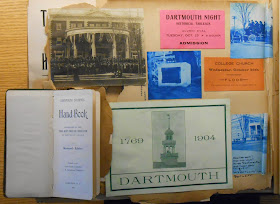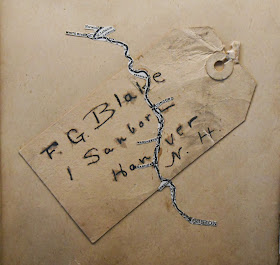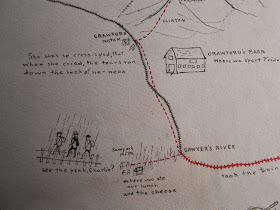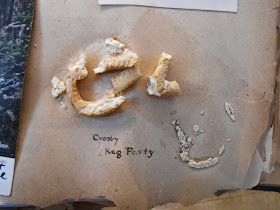 At a point in 1904 or 1905, Francis Gilman Blake pasted the “Dartmouth Students’ Hand-Book 1904–1905” into his Memorabilia from College Days scrapbook. The Handbook, an object within a larger object, provides a glimpse into both Francis Blake’s life, and life at Dartmouth College between 1904 and 1908. Blake’s Handbook, an object physically “presented” to him at the beginning of his freshman year provides evidence for advice available to him at the College and the choices he made given such advice.
At a point in 1904 or 1905, Francis Gilman Blake pasted the “Dartmouth Students’ Hand-Book 1904–1905” into his Memorabilia from College Days scrapbook. The Handbook, an object within a larger object, provides a glimpse into both Francis Blake’s life, and life at Dartmouth College between 1904 and 1908. Blake’s Handbook, an object physically “presented” to him at the beginning of his freshman year provides evidence for advice available to him at the College and the choices he made given such advice. As a physical object, the “Dartmouth Students’ Hand-Book” is a small, attractive, dark green leather book with gold imprinted lettering and gold page lining. The Handbook’s size, physical appearance and contents suggest frequent interaction with its owner. The Handbook begins with a map of the Dartmouth campus attached to the inside cover. The presence of a foldout map suggests Dartmouth’s unfamiliarity to the reader therefore implying that the Handbooks intended readers are those unacquainted with the college—freshmen. The authors further clarify the primarily first year student audience in the “Greeting” section by saying “The Young Men’s Christian Association of Dartmouth College extends a cordial welcome to all the students of the College and especially to those who come here for the first time. To the latter, in particular, we present this hand-book containing useful information concerning Dartmouth College.”
As a physical object, the “Dartmouth Students’ Hand-Book” is a small, attractive, dark green leather book with gold imprinted lettering and gold page lining. The Handbook’s size, physical appearance and contents suggest frequent interaction with its owner. The Handbook begins with a map of the Dartmouth campus attached to the inside cover. The presence of a foldout map suggests Dartmouth’s unfamiliarity to the reader therefore implying that the Handbooks intended readers are those unacquainted with the college—freshmen. The authors further clarify the primarily first year student audience in the “Greeting” section by saying “The Young Men’s Christian Association of Dartmouth College extends a cordial welcome to all the students of the College and especially to those who come here for the first time. To the latter, in particular, we present this hand-book containing useful information concerning Dartmouth College.”The Handbook holds a lot of recruitment information for the YMCA at Dartmouth, showing how prevalent Christianity was at the turn of the century at Dartmouth, and it is interesting to compare with today to notice how Dartmouth has changed. By juxtaposing an intention to recruit members to the YMCA by overwhelming the Handbook with information about the YMCA with advice targeted towards first year students, this Handbook presents an image of Dartmouth in the 1900’s tinged with religion which ultimately fades from Francis Blake’s Memorabilia book, illustrating that the YMCA did not hold clout over all of campus. Not only does the Handbook itself overwhelm the reader with information about the YMCA, the College also appears to have been overwhelmed with Handbooks. In the “Student Publications” the authors write: “The Student’s Hand-Book, published annually by the Dartmouth Young Men’s Christian Association, is distributed free to all new students at the beginning of the College year.” To continue the trend, the authors provide explicit recruitment tactics. A direct example of the YMCA pursuing new members from new students occurs in the section “To New Students.” After discussing how new students should commence “Registration and Matriculation,” this section continues by addressing the cost of board and “Text-Books.” A seemingly unrelated sentence follows: “Join the College Y. M. C. A. during your first days in College.” Following a formulaic instruction manual about how to behave at matriculation, this statement emphasizes the YMCA’s underlying intention to coerce possible new members into joining. However, instead of utilizing the Handbook and much of its information, Blake pasted the Handbook into his Memorabilia book and appears to have disengaged from the YMCA.
As the author of his own Memorabilia book, compared to the authors of the Handbook, Blake selected the advice he found useful and appears to have avoided much of the YMCA’s advice. Placing this Handbook as an artifact of his own memory changed the nature of advice from one facet of campus, the YMCA, into his own narrative within his Memorabilia book, thus establishing the Handbook as only a small part of his memory of Dartmouth. Although the views of Young Christians at Dartmouth maintained significance for a time for Francis Blake, by deserting the collective views of the YMCA found in the Handbook, Francis Blake effectively established himself as a unique Dartmouth student maintaining only a memory of the influence of the YMCA’s advice. Francis Blake’s Memorabilia From College Days provides insight into how Dartmouth functioned years ago, and looking individually at objects within the book tells us a lot about similarities and differences between students then and now.
Posted for Margot Littlefield '16



